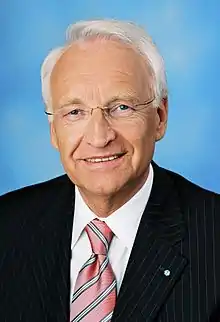2003 Bavarian state election
The 2003 Bavarian state election was held on 21 September 2003 to elect the members to the 15th Landtag of Bavaria. The Christian Social Union (CSU) led by Minister-President Edmund Stoiber achieved the largest majority in German history, winning 69% of the seats in the Landtag. This election was the first and to date only time a single party won a two-thirds supermajority of seats in any German state parliament. The CSU also won its largest proportion of the popular vote since 1974, at 60.7%.
| |||||||||||||||||||||||||||||||||||||
All 180 seats in the Landtag of Bavaria 91 seats needed for a majority | |||||||||||||||||||||||||||||||||||||
|---|---|---|---|---|---|---|---|---|---|---|---|---|---|---|---|---|---|---|---|---|---|---|---|---|---|---|---|---|---|---|---|---|---|---|---|---|---|
| Turnout | 10,248,735 (57.1%) | ||||||||||||||||||||||||||||||||||||
| |||||||||||||||||||||||||||||||||||||
| |||||||||||||||||||||||||||||||||||||
The election was marked by a major decline in turnout, falling by almost 13 points to 57%. As a result, despite achieving its best result in decades, the CSU won 230,000 votes fewer than it had in the 1998 election.
Parties
The table below lists parties represented in the 14th Landtag of Bavaria.
| Name | Ideology | Leader(s) | 1998 result | |||
|---|---|---|---|---|---|---|
| Votes (%) | Seats | |||||
| CSU | Christian Social Union in Bavaria Christlich-Soziale Union in Bayern |
Christian democracy | Edmund Stoiber | 52.9% | 123 / 204 | |
| SPD | Social Democratic Party of Germany Sozialdemokratische Partei Deutschlands |
Social democracy | Franz Maget | 28.7% | 67 / 204 | |
| Grüne | Alliance 90/The Greens Bündnis 90/Die Grünen |
Green politics | Sepp Daxenberger | 5.7% | 14 / 204 | |
Opinion polling
| Polling firm | Fieldwork date | Sample size |
CSU | SPD | Grüne | FW | FDP | Others | Lead |
|---|---|---|---|---|---|---|---|---|---|
| 2003 state election | 21 Sep 2003 | – | 60.7 | 19.6 | 7.7 | 4.0 | 2.6 | 5.4[lower-alpha 1] | 41.1 |
| Infratest dimap | 6–10 Sep 2003 | 1,000 | 59 | 20 | 8 | 4 | 4 | 5 | 39 |
| Forsa | 1–5 Sep 2003 | 1,006 | 61 | 20 | 8 | – | 4 | 7 | 41 |
| Forschungsgruppe Wahlen | 1–4 Sep 2003 | 1,033 | 60 | 22 | 8 | 4 | 3 | 3 | 38 |
| Forsa | 4–8 Aug 2003 | 1,001 | 61 | 21 | 8 | – | 3 | 7 | 40 |
| Forsa | 1–11 Jul 2003 | 1,266 | 59 | 24 | 8 | – | 3 | 6 | 35 |
| Infratest dimap | 14–18 May 2003 | 1,000 | 60 | 22 | 8 | – | 4 | 6 | 38 |
| GMS | 13–18 Feb 2003 | 1,004 | 60.0 | 23.0 | 6.5 | 0.5 | 4.0 | 6.0[lower-alpha 2] | 37 |
| Infratest dimap | 2–5 Jan 2003 | 1,000 | 61 | 24 | 7 | – | 3 | 5 | 37 |
| Infratest dimap | 31 Jul–4 Aug 2002 | 1,000 | 57 | 26 | 5 | – | 5 | 7 | 31 |
| Infratest dimap | 3–7 Apr 2002 | 1,000 | 55 | 28 | 5 | – | 4 | 8[lower-alpha 3] | 27 |
| Infratest dimap | 7–12 Jan 2002 | 1,000 | 56 | 27 | 6 | – | 4 | 7[lower-alpha 4] | 29 |
| GMS | 15 Nov–21 Dec 2001 | 2,014 | 55.0 | 27.5 | 5.0 | 1.5 | 3.5 | 7.5[lower-alpha 5] | 27.5 |
| Infratest dimap | 9–13 Jul 2001 | 1,000 | 54 | 29 | 7 | – | 3 | 7[lower-alpha 6] | 25 |
| Infratest dimap | 3–6 Jan 2001 | 1,000 | 54 | 28 | 7 | – | 4 | 7[lower-alpha 7] | 26 |
| Infratest dimap | 26 Jun–1 Jul 2000 | 1,000 | 57 | 27 | 6 | – | 3 | 7[lower-alpha 8] | 30 |
| Infratest dimap | 3–7 Jan 2000 | 1,000 | 60 | 25 | 5 | – | 1 | 9[lower-alpha 9] | 35 |
| Infratest dimap | August 1999 | ? | 60 | 24 | 5 | – | 2 | 9[lower-alpha 10] | 36 |
| 1998 state election | 13 Sep 1998 | – | 52.9 | 28.7 | 5.7 | 3.7 | 1.7 | 7.3[lower-alpha 11] | 24.2 |
Election result
Summary of the 21 September 2003 election results for the Landtag of Bavaria
| Party | Votes | % | +/- | Seats | +/- | Seats % | |
|---|---|---|---|---|---|---|---|
| Christian Social Union (CSU) | 6,217,864 | 60.7 | 124 | 68.9 | |||
| Social Democratic Party (SPD) | 2,012,265 | 19.6 | 41 | 22.8 | |||
| Alliance 90/The Greens (Grüne) | 793,050 | 7.7 | 15 | 8.3 | |||
| Free Voters of Bavaria (FW) | 411,306 | 4.0 | 0 | ±0 | 0 | ||
| Free Democratic Party (FDP) | 263,731 | 2.6 | 0 | ±0 | 0 | ||
| The Republicans (REP) | 229,464 | 2.2 | 0 | ±0 | 0 | ||
| Ecological Democratic Party (ÖDP) | 200,103 | 2.0 | 0 | ±0 | 0 | ||
| Bavaria Party (BP) | 77,390 | 0.8 | 0 | ±0 | 0 | ||
| Others | 43,562 | 0.4 | 0 | ±0 | 0 | ||
| Total | 10,248,735 | 100.0 | 180 | ||||
| Voter turnout | 57.1 | ||||||
Notes
- 2.2% REP, 2.0% ÖDP, 1.2% Other
- 1.0% PDS, 0.5% REP, 0.5% ÖDP, 4.0% Other
- 2% Right-wing parties, 6% Other
- 2% Right-wing parties, 5% Other
- 3.0% PRO, 1.0% REP, 1.0% PDS, 0.5% ÖDP, 2.0% Other
- 2% Right-wing parties, 5% Other
- 2% Right-wing parties, 5% Other
- 2% Right-wing parties, 5% Other
- 3% Right-wing parties, 6% Other
- 3% Right-wing parties, 6% Other
- 3.6% REP, 1.8% ÖDP, 1.9% Other


